HUMAN SERVICES COMMITTEE – OCTOBER 16, 2018
THOMAS C. BUCKEL, JR., CHAIRMAN
MEMBERS PRESENT: Mr. Rowley, Dr. Chase, Mr. Bush, *Mr. Jordan
ALSO ATTENDING: See attached list
Chairman Buckel called the meeting to order at 10:02 a.m. and stated for the record, “Mr. Jordan is in court.”
A motion was made by Mr. Bush, seconded by Mr. Rowley, to waive the reading of the proceedings from the previous committee. MOTION CARRIED. A motion was made by Dr. Chase, seconded by Mr. Bush, to approve the minutes of the previous committee meeting. MOTION CARRIED.
1. CHILDREN AND FAMILY SERVICES: Amy McCluskey, Director, Youth Bureau
a. Authorizing Execution of Agreements with the City, Towns and Villages of Onondaga County for Operation of Youth Programs for 2018 – 2019
Ms. McCluskey:
-
Annual resolution administers funds to town and village service and recreation programs
-
Youth Bureau receives about $460,000 from NYS for youth development, use competitive process to allocate about $330,000, $50,000 used for admin, remaining $80,000 goes to municipalities based on 2013 calculation per capita; state-issued funds directly to towns and villages prior to 2014 when it was passed onto the county for administration, county, in conversation with the legislature, decided to keep funding at the 2013 level
Mr. Bushed asked the amount per capita. Ms. McCluskey responded that it is a state calculation that was determined prior to her time - unsure of the exact amount but will find out. Mr. Bush stated that the small amount is hardly worth the administration. Some municipalities do not participate because the amount is not worth their time. Ms. McCluskey agreed, adding that there is a lot of paperwork. In answer to Mr. Bush, Ms. McCluskey confirmed that the amount is administered based on the state's formula. Chairman Buckel stated that $168 would go to the Village of Jordan, which is a small chunk of the $150,000.
Chairman Buckel asked if the funds were repetitive or the county applied for the grant each year. Ms. McCluskey responded that the grant is repetitive. They must submit applications for each of these programs to the state and then submit claims. Chairman Buckel questioned the estimated time used to complete just the application process. Ms. McCluskey said the process takes a couple of months, about 40 hours total. Chairman Buckel stated that $150,000 was nothing to sneeze at but then there is the additional time of coming to the legislature, cutting checks, accessing and detailing each account. He then questioned if a cost analysis was ever completed to determine the administrative costs for these funds. Ms. McCluskey responded that it was a lot of paperwork and a lot of the smaller towns and villages don’t have the resources. The state also requires an annual assessment and many have difficulty measuring. Chairman Buckel suggested the administrative side determine a way to for computerized automation, a portal that supports these through the town, villages, county, and state. Ms. McCluskey responded that they will brainstorm and try to think of ways to make it easier for municipalities.
Ms. McCluskey stated that the Village of Jordan uses their funds for swimming pool chlorine and that is a lot of paperwork just to pay for chlorine. Mr. Bush said that allowing municipalities to apply for larger project funds would provide more of an impact than trying to distribute yearly funds to 19 towns and 15 villages, but the county is forced to do it this way because of a certain formula. Chairman Buckel added that not only is there a certain amount of money, but there are also qualifications that are very narrowly funneled into this and there are probably hundreds of these. Ms. McCluskey said that the funds can be used in a competitive bid process but the decision was made to keep this funding for towns and villages. Mr. Bush stated that many communities have a problem accumulating large enough sums of money to make an impact, they get dribbles. This could be a place for them to go, and then not receive funding again for 5 years. Mr. Buckel stated that the federal block grant provided this funding years ago. Mr. Bush agreed, adding that they then changed the way things were evaluated. Chairman Buckel stated that maybe the county could do something similar. Mr. Bush responded that he hopes the county will step in.
A motion was made by Mr. Rowley, seconded by Dr. Chase, to approve item 1a. Passed unanimously; MOTION CARRIED.
b. Concerning Certain Proposed Additions and Renovations to the ,Onondaga County Hillbrook Juvenile Detention Center; Approving the Classification of an Unlisted Action under the State Environmental Quality Review Act (SEQRA); Accepting the Environmental Assessment Form; and Accepting and Adopting the Negative Declaration
Dr. Chase questioned why this is being done. Chairman Buckel explained that state environmental laws require construction projects to comply with certain standards. Environmental concerns have to be addressed and in the absence of environmental problems, a negative declaration must be passed. Almost every project comes with a negative declaration, though he does not want to suggest pro forma. Chairman Buckel referred to legal counsel. Mr. Frateschi responded that under Part 617 of the New York Code of Rules and Regulations anytime you take an action that may affect the environment you are required to consider the environmental impacts of that action. There must be a record that you thought through the process, and the environmental impacts have been reviewed. You do not have to have to be experts – just use your reasonable judgment to determine if the 4,000 square foot building expansion will have a significant environmental impact.
Dr. Chase said that basically they are saying things are fine and can move forward, and we would then be saying we believe them. Mr. Frateschi responded that it is not about moving forward, it is about the environmental impact. Mr. Durr stated that all it says is that they have taken into consideration possible environmental impacts for that area and as far as they can tell it will not impact the environment. Mr. Buckel stated that we rely on the administrative arm of this government to tell us but they also provide background information on the considerations. Generally, any issues are worked out before this point. Dr. Chase said that she is questioning this because we have done many of these and this information comes along with the project.
A motion was made by Dr. Chase, seconded by Mr. Rowley, to approve this item. Passed unanimously; MOTION CARRIED.
Chairman Buckel:
- This committee was reformed at in response to his suggestion; recent experience in the world with poverty lead to his interest to return
-
Response to his comments on the budget were fair, he did not put up alternatives, now intends to present ideas for consideration and work with the administration; distributed articles that describe some of his thoughts:

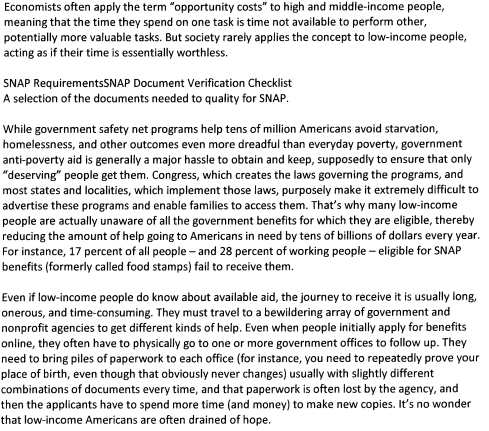
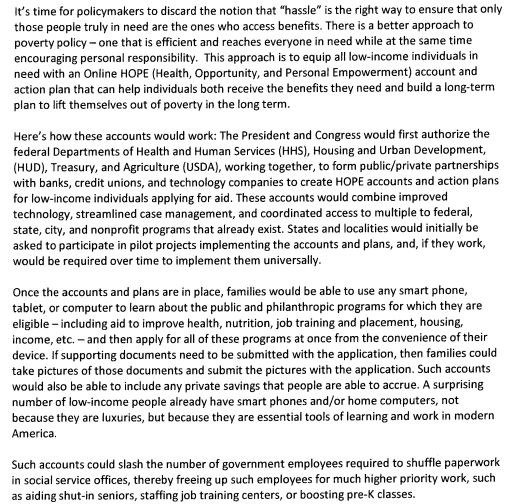


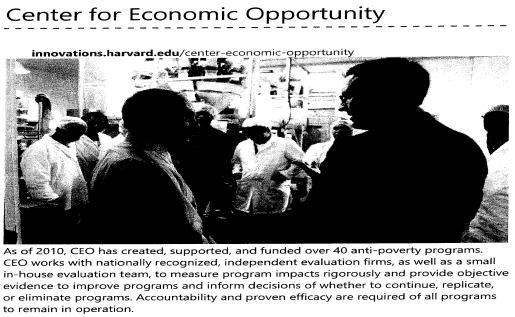
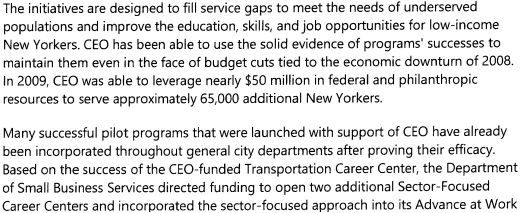
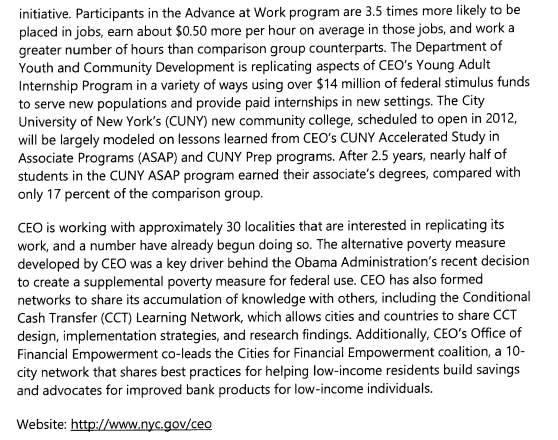
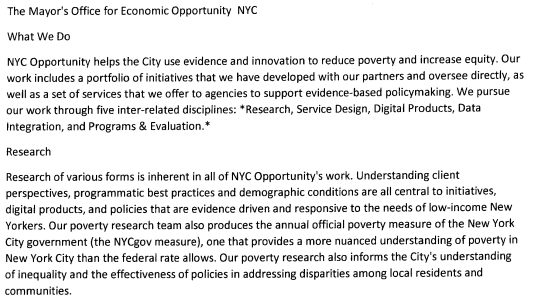
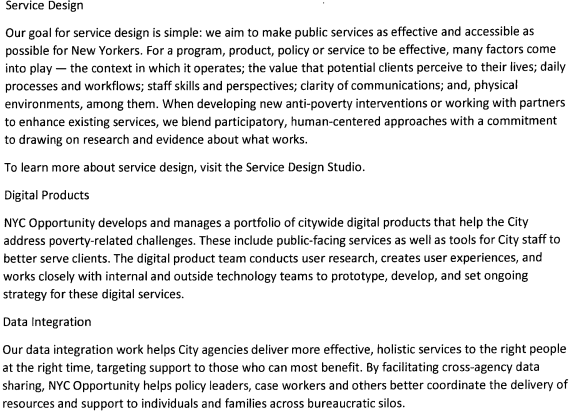

- Wants to plant the seed for consideration on different poverty initiatives and follow some best practices; informational only – no discussion needed
Dr. Chase:
- Many issues revolve around poverty, transportation is one of the big problems, bus availability is less than stellar and they don’t make enough to afford cars, insurance, etcetera
Chairman Buckel:
- 2 big picture categories represented in these articles:
1. Streamline the way services are made available in exchange for recipients individualized responsibility – today’s system is reactive, passive, and requires dependency on the caseworker
2. Best practices for individual subjects, i.e. NYC leader in how to create, manage, and monitor with data the effectiveness of programs; transportation is one subject
Dr. Chase:
-
del Lago expanding, trying to partner with the city to get people to work there, willing to provide transportation to and from a hub to work and back; may be worthwhile for other employers to have the same type of program, expensive to hire new employees, much downtime, benefits all when people remain in their job
Chairman Buckel:
-
Dr. Chase described private sector response to need – interesting
-
Can provide the solution to the individual but this is limiting and creates more harm than good - with federal government waiver and support want to find a way to streamline efficiency and make it less demeaning to apply for benefits in exchange for more individual responsibility, taking control on every issue from transportation, to childcare, to food
- Currently, everything is reliant on someone telling them what they have to do next, want to break this cycle and use this county as a model
Mr. Rowley:
*Mr. Jordan arrived at the meeting.
Chairman Buckel:
-
Want to explore the potential formation of a military school in Onondaga County, purpose is to provide an opportunity for all students, traditionally only given to wealthy students; there is a population that could use that kind of discipline and structure, not just one group or race, there is a need throughout the area for a different kind of structure to deal with those that keep falling through the cracks
Mr. Bush:
- Great idea, someone could take the idea and run with it; a certain demographic would thrive in that environment, a real cross section
A motion was made by Mr. Jordan, seconded by Mr. Rowley, to adjourn. MOTION CARRIED.
The meeting adjourned at 10:30 a.m.
Respectfully submitted,

KATHERINE M. FRENCH, Deputy Clerk
Onondaga County Legislature
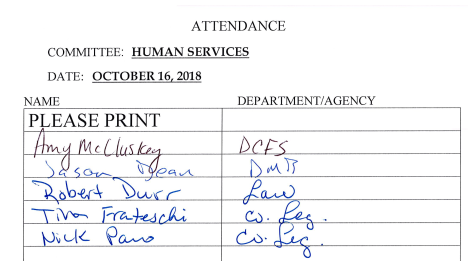
* * *
COUNTY FACILITIES COMMITTEE MINUTES – OCTOBER 16, 2018
AT ROSAMOND GIFFORD ZOO, 1 CONSERVATION PLACE
JUDITH A. TASSONE, CHAIR
MEMBERS PRESENT: Ms. Cody, Mr. Holmquist, Mr. Knapp, Mrs. Ervin
ALSO ATTENDING: See attached list
Chair Tassone called the meeting to order at 12:32 p.m. A motion was made by Mrs. Ervin, seconded by Mr. Knapp to waive the reading of the minutes of the previous committee meeting; MOTION CARRIED. A motion was made by Mrs. Ervin, seconded by Ms. Cody to approve the minutes of the previous committee meeting; MOTION CARRIED.
1. FACILITIES MANAGEMENT: Archie Wixson, Commissioner
a. BOND RESOLUTION: A Resolution Authorizing the Construction of Improvements at Oncenter in and for the County of Onondaga, New York, at a Maximum Estimated Cost of $1,500,000, and Authorizing the Issuance of $1,500,000 Bonds of said County to Pay Costs Thereof ($1,500,000)
-
Asking for funds to make improvements at OnCenter Complex; theaters - $750,000 each year (2 years)
-
Focus this year:
- Replace theatrical draperies and acoustical panels on walls, and fire curtains separating the stage from back stage in case of (i.e.) pyrotechnic accident
- 8 dressing rooms with toilet and shower area in need of tile replacement; original to building – 1974
- Crouse Hinds Theater – ADA improvements with creative seating arrangements; both theaters difficult for ADA with drastic sloping; back then did not terrace it; ADA compliant, but not good inclusion; looking for this year
-
Smaller theater – not sure will be successful with ADA without eliminating a lot of capacity
-
Crouse Hinds Theater – more active, more performers; need to do something
-
Theatrical and acoustical draperies price tag of $260,000; did bid, but unable to award; short on funds
-
Fire curtain price tag $170,000 - every 10 years need to be recertified, and they cannot be recertified anymore
-
Been to theatrical drapery companies like Syracuse Stage & Scenery who tested them, but did not recertify them; they cannot guarantee that another fire retardant treatment will not damage the original curtains
-
Codes Enforcement Officer James Wood directed that within this year the curtains are either recertified or replaced
-
The curtains are an asbestos textile
-
Retiling of 8 toilet rooms with adjoining showers estimated at $60,000
-
Allocated $150,000 - $200,000 to manage ADA seating opportunity at Crouse Hinds
-
2015 - 2016 replaced theater roof; this year did Civic Center Office Tower
Chair Tassone asked if there is any money left from the previous bonding, and Mr. Wixson responded that there will not be after the War Memorial projects are completed. There is less than $100,000, which will be used for production control (interfacing with scoreboard, marquees and public media display).
Mr. Holmquist asked if there is anything else on the horizon for the theaters after this work is completed. Mr. Wixson replied there are placeholders in the book for continuous improvements at the Convention Center, and they are a little short on having the nice, executive look to the meeting rooms. The ballroom is dated, and needs an upgrade. Mr. Wixson said they planned on doing lighting upgrades in the ballroom three years ago, but the folks that investigated it, had underscored it. When the bids came in, they were three times the amount estimated. It could be one of the primary focuses of next year’s request for $750,000. Mr. Holmquist asked if there is anything else with the theaters, and Mr. Wixson answered that there are continuous upgrades that have been ignored; including the original seating. They will have to look at reupholstering or replacement in both theaters.
Mr. Wixson responded to Mr. Knapp that Crouse Hinds Theater can seat 2,200 – 2,600, and the Carrier Theater is just under 900. The BeVard, which is primarily a community theater, has handicap access, but it only seats just over 100 people.
A motion was made by Mr. Knapp, seconded by Mrs. Ervin, to approve this item. Passed unanimously; MOTION CARRIED.
Mr. Wixson stated that Facilities intends to fully support Parks with their resources for the veterinary medical clinic, and will work with them for this important project.
2. PARKS AND RECREATION: William Lansley, Commissioner
a. BOND RESOLUTION: A Resolution Authorizing Various Improvements to Parks and Recreation Areas in and for the County of Onondaga, New York, at a Maximum Estimated Cost of $1,697,000, and Authorizing the Issuance of $1,697,000 Bonds of said County to Pay Costs Thereof ($1,697,000)
-
Introductions: Dan Meates, General Curator; Seth Groesbeck, Lead Elephant Trainer; Janet Agostini, President of Friends of the Zoo; Ted Fox, Director of the Zoo
-
Capital request for various parks improvements including Highland Forest administration office; Jamesville Beach for replacing AC units
-
Lee Klosowski instrumental in assessing needs of parks for energy management systems
-
Lot of systems using R22 refrigerant (no longer available); putting plan together to replace units as they get older in places like offices or lodges for weddings – do not want unit going down during ceremonies
-
Old furnaces at Highland Forest; Patrol Office; Beaver Lake Maintenance Building; antique boilers at administrative office and garage in Liverpool ($200,000)
-
Zoo – aquarium areas are humid, which deteriorates anything metal; upkeep essential for exhibits
-
Stadium suits – AC units original; some have been replaced, but others are starting to fail, will replace as needed
-
Highland Forest – original fire suppression system; piping system from generators to compressors, which produce water in systems; pipes have pinholes; replaced sections when alarms go off; looking to replace entire system
-
Continuation of comfort stations – Onondaga Lake Park Willow Bay – renovate restroom ($645,000)
-
Carpenters Brook – $302,000 for lining fishponds; 18 round ponds and 12 rectangular; all original to 1933; previously given $100,000 for concrete repair in ponds, but have not spent; advised by concrete company to make concrete repair, immediately followed with fiber glass inserts to protect the concrete work; put off work until funding for fiber glass
-
$750,000 – Park’s road paving and trail improvements; Carpenter’s Brook main entrance road (long, elevated road traveled by trucks with heavy duty loads); repaving internal roads of Veteran’s Cemetery in need of scrape and repave
-
Remaining portions – did trail from Willow Bay to SU Boat House; section remaining, because of John Glenn construction had heavy duty equipment there - $70,000
-
Both roadways to Brockway and Pratt’s Falls - $310,000
Chair Tassone stated the Zoo is informational, but was not sure if this was also informational. Chair Tassone said the committee will vote on item 1a.
Mr. Knapp said part of the ask is for NBT Bank Stadium, and asked if this is something they should hold out on with the renovation and upgrades that are coming. Mr. Lansley responded that they can do that. Mr. Lansley clarified that they do not want to replace these units now, but would like the money available for when they fail. This is general maintenance. If this was approved now, and became part of the renovations, then they would take the money out.
Mr. Knapp asked if the road replacement is gravel or pavement. Mr. Lansley answered they are scraping and paving. Nothing is newly paved.
A motion was made by Mrs. Ervin, seconded by Ms. Cody, to approve this item. Passed unanimously; MOTION CARRIED.
b. BOND RESOLUTION: A Resolution Authorizing the Construction of a Medical Care Center at the Rosamond Gifford Zoo in and for the County of Onondaga, New York, at a Maximum Estimated Cost of $8,000,000, and Authorizing the Issuance of $8,000,000 Bonds of said County to Pay Costs Thereof ($8,000,000)
- Contracting for design of new medical center; going through project design to schedule for next year
- Current medical area ¼ of size of meeting space; new building will be in a vacant lot with fencing line on southwest side
Mr. Fox
-
Necessity of quarantine – currently connected to small clinic; from medical perspective, not okay; no real quarantine when isolating animals in different room, but still breathe same air
-
Standalone quarantine building will not contaminate clinic area – new AZA standard to adhere to
-
Square footage – 1,800 - 2,500 sq. ft.
-
Want significant element of education; importance of welfare and care of animals - in surgery suite and treatment room
-
Area for school groups to use microscopes; see lab work on other side of glass wall
Chair Tassone requested Mr. Fox send the most recent pictures and information to the committee.
Mr. Fox stated the new site is beyond the perimeter fence. There were also ideas with the new funds to support engineering and design. Mr. Fox continued about veterinary care:
-
Contract with Cornell University with 2 primary Veterinarians that come up 3 – 4 days/week; on call 24 /7
-
Brought up there is spotty coverage; through accreditation, engaged in contract with local Veterinarian to fill in if there is an emergency, and Cornell cannot get there
-
There are 2 residents through Cornell’s Exotic Animal Medicine Program; 1 - 3 interns; teaching opportunity for Cornell
-
Cornell brings 1 - 4 students every time they come to get practical experience with exotic animals
-
Cornell does not want to work with zoos that are not accredited; this is the closest one; 23 years working together
-
Cornell excited about this; talked with Dean of Vet School on whether they wanted to do enhancements; there are educational opportunities and research
-
Accreditation - Zoo needs to participate with contemporary research projects with their species; would like to develop that even more ; currently working with penguins, elephants, and sloths; opportunity to further research space
-
Talked about ability to have techs from Cornell come up and help with research clinics
-
This is in plan for 1 year of construction; this year is design and next year construction
Mr. Lansley stated that construction can take a full summer without interfering, because it is not in the Zoo proper plot. The committee can see the boardwalk project on the tour, which is being done in the fall so as not to impact the summer season.
Mr. Fox said that part of the accreditation hearing is that the AZA wants an update in six months and a year to show the Zoo is moving forward. Mr. Knapp asked how the hearing went. Mr. Fox responded that it went well. After the Lead Inspector came, there was nothing negative to say. Mr. Fox said they are doing everything they can to get things done, and this is a great plan moving forward. There were kudos given for the programs offered, the association with the Friend’s group, the education, animal programs, and safety. All plans and protocols are exemplary to them.
Mr. Knapp asked if Cornell would be interested in sponsoring anything. Mr. Fox answered that Cornell wanted to see how far this would go, and once it is confirmed, there could be a conversation. Cornell is aware of how beneficial it will be. They want to do the research portion, and there has been a conversation about increasing their contract to have a fulltime Veterinarian at the Zoo; who would be employed by Cornell. Mr. Knapp asked what level of equipment they will have. Mr. Fox replied that they would not get to the level of CAT scans until they have the space. Digital Radiography is what everyone uses. The Zoo is currently taking films. If they have digital, they would be able to send those to Cornell to have a Radiologist read them. The Friend’s group got new dental equipment, and the surgical tables and equipment for the new building will need to be addressed.
Chair Tassone stated there would not be a vote on this item.
A motion was made by Mrs. Ervin, seconded by Mr. Knapp, to adjourn the meeting. Passed unanimously; MOTION CARRIED.
The meeting was adjourned at 1:05 p.m.
Respectfully submitted,

JAMIE McNAMARA, Assistant Clerk
Onondaga County Legislature
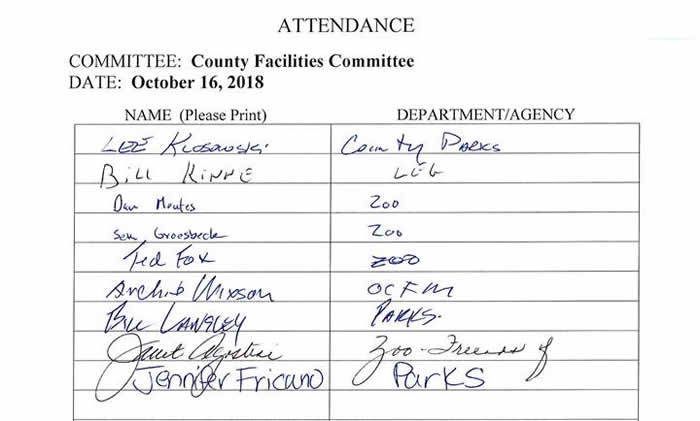
* * *
ENVIRONMENTAL PROTECTION COMMITTEE - OCTOBER 17, 2018
MICHAEL PLOCHOCKI, CHAIRMAN
* * *
PUBLIC SAFETY COMMITTEE MINUTES – OCTOBER 17, 2018
CHRISTOPHER J. RYAN, CHAIRMAN
MEMBERS PRESENT: Mr. Rowley, Mr. Bush, Mr. Jordan
MEMBERS ABSENT: Mr. McBride
ALSO ATTENDING: See attached list
Chairman Ryan called the meeting to order at 12:08 p.m. A motion was made by Mr. Jordan, seconded by Mr. Bush to waive the reading of the minutes of the previous committee meeting; MOTION CARRIED. A motion was made by Mr. Jordan, seconded by Mr. Rowley to approve the minutes of the previous committee meeting; MOTION CARRIED.
Chairman Ryan stated items 2 and 3 are informational, which will give the committee a month to look over. They will come back for a vote next month.
1. JUSTICE OVERSIGHT COMMITTEE: Barry Gewanter, Executive Director
a. Confirming Appointment to the Onondaga County Justice Center Oversight Committee (Jennifer C. Yolles, M.D.)
-
Candidacy result of Dr. Nave asking for people to volunteer for committee; interviewed by myself and Marissa Mims
-
Dr. Yolles at a point in career and family life to be able to give back; want opportunity to give back in substantial way; has the chops and critical thinking; perfect fit
A motion was made by Mr. Jordan, seconded by Mr. Bush, to approve this item. Passed unanimously; MOTION CARRIED.
2. SHERIFF’S DEPARTMENT: Captain Paula Pellizzari
a. BOND RESOLUTION: A Resolution Authorizing the Reconstruction/Construction of Improvements at the Corrections Facility in and for the County of Onondaga, New York, at a Maximum Estimated Cost of $368,000, and Authorizing the Issuance of $368,000 Bonds of said County to Pay Costs Thereof ($368,000)
2019 projects:
-
Facility roadway paving entry and egress area - $75,000 in 2019, $75,000 in 2020 and $85,000 in 2021 = $235,000 over 3 years; includes paving for entry, upper parking lot, areas around warehouse and fitness center
-
AC for housing units 1, 2, 3 - $146,000 in 2019; $146,000 in 2020; $147,000 in 2021 = $439,000; housing units never had AC before; unit 4 separate project in 2017 (electrical issues trying to resolve, so not included); units 5-8 have AC
-
Inmate housing unit entry and cell door replacement – $24,000 in 2019; $24,000 in 2021 = $48,000
-
2019 priority is unit 1 with special housing; 16 doors in B section where high security inmates held - new doors will have hatch to handcuff inmates through opening, making it safer for officers
-
Programs corridor ceiling replacement including classrooms and multipurpose room; $10,000 in 2019, $10,000 in 2020; $12,000 in 2021 = $32,000; install drop ceiling in library, 4 classrooms, multipurpose room and office
-
Hot water on demand in housing units; $11,000 in 2019, $11,000 in 2020, $31,000 in 2021 = $53,000; request for hot water in unit 8 and 9; all others changed in last 3 years; expected to last 20 years
-
Lighting on facility roadways - $24,000 in 2019; $24,000 in 2021 = $48,000; remove high pressure sodium street lamps and replace with LED lamps; reduce electricity costs and have brighter lights
Mr. Rowley said this year they borrowed $325,000, and asked how the projects are going. Also, are there any special considerations for doing the projects, because of the population? Captain Pellizzari responded:
-
2018 project for kitchen and housing unit floor areas - 1 vendor gave quote for both areas; completed housing unit floors; vendor backed out of kitchen floor project; did with another vendor
-
Kitchen floor not installed yet; PO issued; waiting for dishwasher project; PO just issued; 11 week manufacturing time; going to do installation of kitchen floor with dishwasher install; expect kitchen closed for 7-10 days; plan in place to move meals from Justice Center to Jamesville and serve there
-
Food service delivery carts – custom built on bid; delivered in July; few issues with carts, and vendor has been very responsive; no issues now; still have 3 ½ months left on warranty
-
Laundry washing machine complete
-
Vendor scheduling – done on sight by Correction’s staff; have not heard of any concerns with scheduling or hours
Chief Andrews stated vendors are scheduled during business hours, each vehicle is searched, and there is a whole procedure of getting into the facility for any vendors coming in. Mr. Rowley asked if there is anything specified in the bid, and Captain Pellizzari replied, not that she’s aware of. There are no safety concerns.
Chairman Ryan asked for more information on the paving. Captain Pellizzari responded that the Sergeant in charge of the maintenance crew explained that they got quotes when this was requested through the CIP process. They wanted to start in the spring of 2019. It includes the entrance area to the guard shack, the upper parking lots, the road from the main facility to the laundry building, the fitness center, and the employee entrance from Taylor Road. Chairman Ryan asked if this would ease congestion, and Captain Pellizzari responded that she’s not sure there is a congestion issue. Chairman Ryan asked if they all go in the same entrance, and Captain Pellizzari believes they do.
Captain Pellizzari responded to Mr. Bush that the paving will start in 2019 at $75,000, $75,000 in 2020, and $85,000 in 2021. The staff there would obtain quotes when putting these requests together. Some costs may change. Mr. Bush assumes they are paving over time because of budget issues, rather than all at once. Captain Pellizzari is not sure why they are spreading it out over three years. Mr. Bush asked if the 2018 projects are staying within their estimates. Captain Pellizzari replied that the carts came in less than projected; $158,000 projection, and cost was $109,000. The dishwashing machine was in the CIP at $101,000, and was awarded at $82,000. Captain Pellizzari responded to Mr. Bush that they will have extra money in 2018. The kitchen floor is not done yet, so the costs could change when they rip up the floor. Chairman Ryan said they will wait and see what the cost savings are, and what they have left. Captain Pellizzari explained that the initial vendor for the kitchen floor came in at $29,000, and the new vendor came in at $31,000 for the floor alone. The original vendor had concerns with the project.
Chairman Ryan requested, by next month, a list of everything that has been done, what is completed, what work is ongoing, how much is budgeted, and where everything is. Captain Pellizzari has it in writing, and will put in electronic format.
3. EMERGENCY COMMUNICATIONS: William Bleyle, Commissioner
a. BOND RESOLUTION: A Resolution Authorizing Various Improvements to and Replacement of Emergency Communications Facilities and Equipment in and for the County of Onondaga, New York, at a Maximum Estimated Cost of $5,756,000, and Authorizing the Issuance of $5,756,000 Bonds of said County to Pay Costs Thereof ($5,756,000)
1st Project:
- Replacement of auxiliary power systems – 911 center built in 1990; occupied in 1992
-
Backup power systems now 25 years old; replacement parts harder to find; center too large to fail; 6th largest in northeast
-
Common practice for most centers to have 2 generators; radio system at main center; sophistication of computer systems; reliable solid power important
-
Looking to add generator; main generator 25 years old and kept indoors; fairly decent; can serve as backup
-
Replace transfer switch (25 yrs old); replace UPS system (reaching end of life)
-
Utility power comes into UPS, then converted to battery power and reconverted to AC power
-
$688,000 allocated to replacement and updating auxiliary power systems
2nd Project:
3rd Project:
- Aerial imagery refresh; important to call takers and dispatchers
-
70% of calls for 911 are wireless; people do not know where they are; can get approximate location; margin of error
-
Refer to imagery to describe what’s around including billboards, barns, etc. to pinpoint location of event
-
Google earth is not oblique imagery; oblique allows to see face of building, colors, doors, etc.
-
(i.e.) Missing children – see pools in backyards, etc.; use imagery for out buildings; things in woods
-
Not just 911 uses imagery - SOCPA relies on it, towns and villages use it, assessor’s offices, etc.
-
Approximately $300,000
-
Always been under Emergency Communication’s budget; work with Planning; last time for update in 2014 some funding came through grant SOCPA had
Mr. Jordan commented there was some 911 grant money, SOCPA found money, and some money from real property.
Mr. Bush asked if this is done in real time. Mr. Bleyle explained that it is a fly over. The department hires a company to do a fly over with sophisticated high resolution cameras, and they put a map together. Mr. Bleyle responded to Mr. Bush that all the dispatchers have this available to them. It is not a drone. It is imagery, and the last time it was done was in 2014. Chairman Ryan asked if this is an industry standard. Mr. Bleyle responded that different agencies do it different ways, because it is a lot of money. They generally do it when E911 or Planning starts seeing changes rendering it obsolete. Chairman Ryan said in four years a lot can change, and it can save a life. Mr. Bleyle commented that it is expensive to do every year, but it would be wonderful.
Mr. Jordan explained that this is a web based application, so they are able to create user accounts for eligible organizations. There are 300 users from over 40 organizations including County departments and municipalities. It is a nice way to make data available to users.
Chairman Ryan stated that in the future the cell towers will communicate better with devices, so they can pinpoint locations better. Mr. Bleyle said they are in the process of implementing technology to allow them to do this.
4th Project:
- $265,000 – Public safety radio tower replacement
- Rose Hill Tower – came last year; in bad shape when inherited
- Makyes Tower – no idea how old tower is; at least 40 years old; original fire patrol days
- Low grade tower; not public safety grade; originally one antenna on the tower; added microwave dishes
- At max capacity; problems with galvanizing; keep it protected; been identified by maintenance needs replacement
- $339,000 to replace Rose Hill Tower; $265,000 to replace Makyes Radio Tower
5th Project:
-
Replacement of Mobile Data Communications Network – voice radio primary communications; rely heavily on data communications; all police, fire and emergency vehicles equipped with automatic vehicle location
-
Currently use Data Radio System to get information back to 911 center; use data radio to send calls to field; responder can look at notes taken by call taker, can enter own notes, get caution information, and other information
-
Data technology more than 10 years old; originally installed in 2007
-
(i.e.) Law enforcement migrated to air cards, broadband connectivity; more detailed searches and license plates
-
E911 interfacing data radio system and CAD information with broadband network in cars
-
Looking for one size fits all application – installation of mobile routers that have capability of multiple applications; can connect with broad band; wifi in vehicles; officer has iPad, can communicate with police vehicle and station
-
Have to move into next evolution because system is now 10 years old and obsolete; modems in police, fire and EMS vehicles are 10+ years old, and getting hard to repair; new generation of communication devices
Mr. Jordan had a constituent complain that police were pounding at his door, and it turned out they were at the wrong house. If it was a domestic situation, there was concern for safety of police officer. Mr. Bleyle explained:
-
If they get a call from a wireline phone, chances are good that they know where the person is
-
(i.e.) If there is a data clerk entering Main Street in Elbridge, when it’s Main Street in Minoa, then the person in Elbridge dialing 911, will show up as the address for Minoa
-
When calling 911, the call taker will always ask where the person is; many common street names; room for error
-
Wireless phone accuracy is all over; getting more accurate, but can be within 2 meters, or 20-30 meters
-
FCC gave wireless providers until 2021 to get that spot on accurate
-
(i.e.) If ordering a pizza from an app, they know exactly where the person is, because it goes through GPS
-
911 is an analogue call, so data is not delivered to the 911 center; they are working with a company to get that implemented (so data can be delivered)
-
Currently get information based on triangulation; depending on what towers hear the call; if in a rural area, it can be very difficult; responders have to knock on doors to find the right place
-
If police cannot find the person, dispatchers try to call back; get calls from non-initialized phones; if there is no service on the phone, the person should still be able to dial 911 – little information from those calls
Mr. Jordan asked if there is potential danger, is that relayed to the police officer. Mr. Bleyle responded yes. The call takers go through several hours of classroom training, and what the call takers have to ask (i.e. weapons, intoxication) is formatted.
Mr. Rowley asked if there is any way to break up the proposal for the $5.7 million to bond. Mr. Bleyle replied that these were the plans put in place over the length of the capital plan. The public safety tower replacement is possible, and the imagery should be done. The backup power plan is critical. Mr. Rowley asked if there’s any way they would get the $5.7 million done over the next year. Mr. Bleyle answered that it is an aggressive capital project plan, but it’s their goal. Many of these things they would need to hire an engineering firm, because it would have to be done on live systems. The oblique imagery fly over is generally done in the Spring or Fall, so nothing is obscured by trees. CAD is usually done in a four-year cycle, and they are on six years. Data communications has been pushed off since 2016, when they hired a consultant. All the projects are things that need to be done. Mr. Rowley is not questioning that, but as a Legislator, this is approving a big chunk of money, and without communication, they lose track of why and what is being done. Mr. Bleyle said they have a capital project plan for 4 – 5 years that are upgrades to tower facilities. Every year they chip away at that. Some of this may go that way.
Mr. Rowley asked if there is a market for the used equipment they are replacing. Mr. Bleyle responded that they send what they can to auction, but computer hard drives are destroyed because of the information contained on them. The cost of replacing the tower includes the cost of the scrap steel price. The transfer switch would be turned over to auction. Mr. Rowley encouraged Mr. Bleyle to spread this out over a couple years.
Mr. Jordan said technology changes rapidly and expensively, and asked if they should hold off on anything that might be something newer and better in another year. Mr. Bleyle said it is a good point, but one challenge is the cost of 911 escalating. Next generation of 911 is all VoIP (data) from a copper phone system. They are constantly being mindful of where technology is going, and what they have.
Chairman Ryan said that a big part of the ask is the replacement of the data communication at $3.6 million, and asked if the County will be in a good spot through 2021 with the wireless callers. Mr. Bleyle said in 2016 they hired a consultant and looked at the technology coming down the line. The decision was held off to find out if FirstNet was viable, and if the modems would be compatible with Band 14; they were not.
Mr. Bleyle responded to Chairman Ryan that the radio system is how multiple counties join in to share money. Madison County is looking at the potential of consolidating with Onondaga. 911 has seen multiple consolidations on the county level, and the prediction is that there will be regional centers for the state. It is in Vermont, because of the cost of technology. Mr. Jordan asked how a smaller county could dovetail with the systems that Onondaga County has. Mr. Bleyle explained they have a communications consortium to work together to make sure they are compatible. The state pushes grant money to maintain operability. Mr. Bleyle said the push is interoperability, and regionalization of large 911 centers in the next 10 years.
Chairman Ryan stated the committee just received Sheriff’s projections, and Chief Andrews handed out the following:

Chairman Ryan asked Chief Andrews to come back next month, and Chief Andrews agreed.
Chief Andrews said they are projected to come in under budget. The line that says Centralized Arraignment court showing over budget is broken out. The over budget line in overtime would be $369,000 higher than it is showing (it would be close to $2 million over). They are trying to show just what Centralized Arraignment has cost in overtime this year. Chief Andrews explained that overtime would be close to $2 million if they added in the $369,000. The Centralized Arraignment court has put a tremendous burden on the staffing.
Mr. Bush asked if they get involved with reimbursing judges for Centralized Arraignment, and Chief Andrews replied “no.” Last year they were told if they could not live within the budget, they would get reimbursed. The cost was kept separate to show what it costs. Even with the additional amount, they were able to stay within budget.
Chairman Ryan requested the projections at a different date. Chief Andrews said they usually do this on the 6th of the month. Mrs. Maturo asked that the projections be sent to her monthly agenda meetings. Chief Andrews agreed.
Mr. Jordan asked if they were finishing up an academy, and Chief Andrews said they just started an academy. There was a police academy finishing up an FTO, and a couple weeks ago they started a custody/corrections academy. There were 30 spots to fill, 18 came through and 15 are left after losing people. There will be multiple vacancies. They did a recruitment effort, and 307 people signed up for the test. They will have to have another custody and police academy next year. They went through the entire list, and there was no one else to select.
In answer to Mr. Bush, Chief Andrews explained that they have Correction Officers and Custody Deputies. They are covered by the CSEA at Jamesville, and the DSBA at the Justice Center. Mr. Bush asked where the shortage of personnel is the greatest. Chief Andrews said Corrections. There are more openings at Jamesville for Correction Officers, but there are also shortages at Custody. Chairman Ryan thinks they need more money. Chief Andrews said they do not have parity. They start off close together, and Jamesville rates grow slower than DSBA rates. It is part of union negotiations. They are separate unions, so they have to have representation from both sides.
A motion was made by Mr. Rowley, seconded by Mr. Bush, to adjourn the meeting. Passed unanimously; MOTION CARRIED.
The meeting was adjourned at 1:20 p.m.
Respectfully submitted,

JAMIE McNAMARA, Assistant Clerk
Onondaga County Legislature
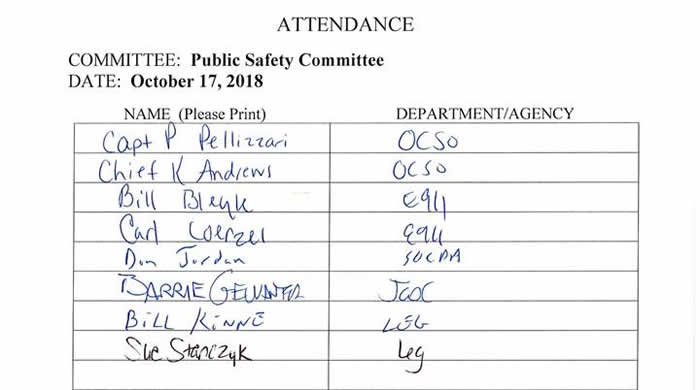
* * *
PLANNING & ECONOMIC DEVELOPMENT COMMITTEE MINUTES - OCTOBER 18, 2018
JOHN D. McBRIDE, CHAIRMAN
MEMBERS PRESENT: Mr. Plochocki
MEMBERS ABSENT: Mr. Holmquist, Mr. Buckel, Mr. Burtis
ALSO ATTENDING: See attached list
Chairman McBride called the meeting to order at 10:40 a.m.
1. VISIT SYRACUSE: Danny Liedka, President/CEO
a. Amending the 2018 County Budget to Make Funds Available for use by Visit Syracuse, and Providing for Agreements as May be Necessary ($45,500)
Mr. Liedka presented the following:
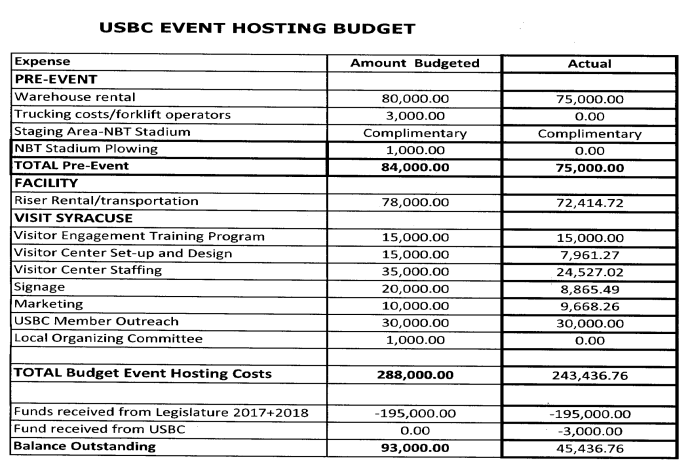
-
2012 County made a commitment to bring USBC here, was made aware of estimated cost over and above the bid fee, $288,000 to operate
-
Managed costs to come in under budget, scaled back temporary labor, remaining balance roughly $40,000 under budget, $45,500 final payment for operational costs
-
Largest expense was warehouse space for equipment, also rental and transport of stadium seating for the Oncenter
-
Outreach expense added when he came on board, made tremendous impact on sales tax generated during bowlers tenure, feared losing them to casinos on either side of the county, used dedicated targeted outreach to bowlers, mainly through high technology apps and text messaging, to engage the bowlers to use our outlets - proud of the outcome, feel ROI is tremendous
Mr. Plochocki congratulated Mr. Liedka on coming in under budget. He is not surprised and thinks the request is more than reasonable. Mr. Liedka said thank you. Chairman McBride echoed Mr. Plochocki’s comments.
Mr. Plochocki asked if there was an estimate as to how much money was spent in the area by the bowlers. Mr. Liedka responded that they are spending a little money for a firm to complete a thorough audit of the spend. The $75 million dollar economic impact floated around is an industry formula that he does not necessarily subscribe to. He can easily account for well north of a $50 million dollar impact; 60,000 visitors, 23% flew in, almost 40,000 hotel nights - generates roughly $300,000 in bed tax alone. He is comfortable that the number will be in the high-fifties, low-sixties.
Chairman McBride stated that the item will move forward to Ways and Means.
The meeting was adjourned at 10:45 a.m.
Respectfully submitted,

KATHERINE M. FRENCH, Deputy Clerk
Onondaga County Legislature
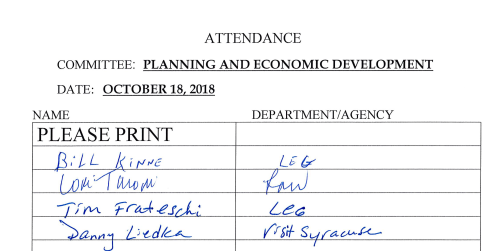
* * *
|





















